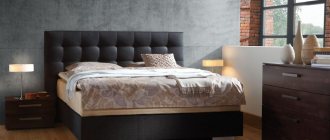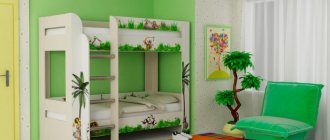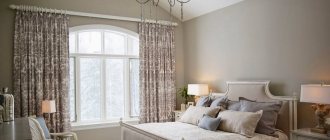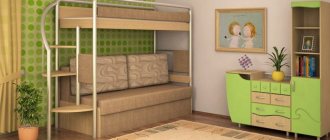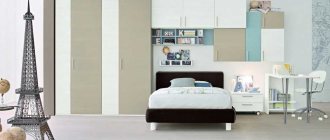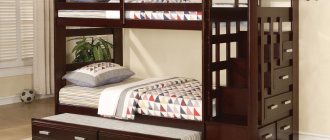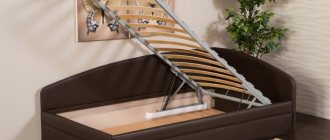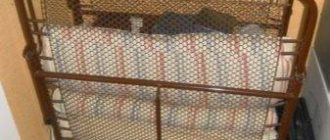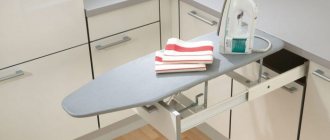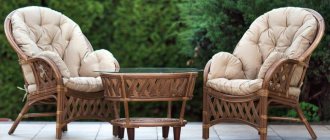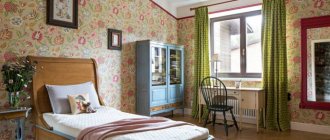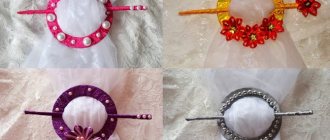© 2022 — 2022 Furniture-one.ru — Copying of materials is strictly prohibited.
Furnishing a child's room is a difficult task. Here you need to provide sleeping places, a work area, and also set aside a place for games. At the same time, psychologists recommend occupying only 30% of the space with furniture. But what if there are 2 children living in the same room? The optimal solution may be to buy a bunk bed. Moreover, modern models can combine the functions of a sleeping place and storage system or sports corner.
Bunk bed - what is it? Design Features
A bunk bed consists of 2 beds placed in 2 tiers: one above the other. This option for arranging a sleeping place has been used since the times of the Ancient World and still does not lose its relevance. It is often used when you need to save space and at the same time accommodate as many people as possible, for example, in hostels, army barracks, etc.
However, do not confuse a bunk bed with a loft bed. The latter has 1 sleeping place upstairs. The lower part is reserved for a work area or place for games.
Advantages of using bunk beds:
- saving space;
- multifunctionality: even if it is not a transformer, children can always use the furniture as an additional place to play;
- saving money, usually buying 1 bunk bed is cheaper than 2 separate ones;
- unusual design: often this piece of furniture becomes central in the room, and the entire interior is built around it.
TOP 3 best manufacturers
Russian manufacturers offer a decent selection of bunk beds with different functionality.
Ascona
One of the largest manufacturers. It has its own laboratory in which new models are tested.
Ormatek
One of the oldest companies, supplies its products to 13 countries of the world, produces beds that meet European quality standards.
DreamLine
Specializes in the production of solid wood beds. These are stylish, reliable, durable, environmentally friendly models.
Classification of bunk beds
First you need to figure out what bunk beds are. They are classified according to different criteria: material of manufacture, configuration, size.
Based on the material of manufacture, furniture can be distinguished from:
- natural wood. These are reliable, durable, but expensive beds. The most budget option is pine. The most durable and reliable is oak. Beech and birch are also good for children's furniture;
- from MDF or chipboard. Glued slabs are inferior in reliability and durability to solid wood, but their service life also reaches tens of years, especially if all fastening and connecting elements are made of metal. However, when purchasing furniture made from MDF or chipboard, you need to check the hygiene certificate: these materials can be toxic.
Types of bunk beds according to design features:
- standard, consisting of sun loungers installed one above the other;
- transformers, i.e. their lower bed can be turned into a sofa, table, wardrobe, etc.
Bunk beds also differ in the arrangement of sleeping places:
- in the classic version, one bed is located strictly above the other;
- beds can stand in a “corner”, i.e. perpendicular to each other;
- “matryoshka”, i.e. one sleeping place rolls out from under the other;
- the beds are placed parallel, but offset relative to each other; free space is occupied by a ladder, wardrobe or bedside table.
Types of bunk beds by shape:
- straight, such furniture can be installed in the center of the room or along the wall;
- corner, i.e. they can only be placed in the corner; this shape can be obtained due to the location of the beds or additional elements, for example, a table.
Sizes of beds may vary. Beds are provided for:
- children;
- teenagers;
- adults
There are combined options, when one bed is larger than the other. However, in general, bed sizes are standardized.
Materials
The three most popular materials for bunk beds are:
- Chipboard. A popular modern material, characterized by a wide selection of colors and budget cost.
- Solid wood. Reliable, environmentally friendly material. It has a longer service life than chipboard, but also a higher price. The most commonly used are ash and beech - these are hard woods with an interesting texture. Service life - more than 15 years.
- Metal. The most durable and strong material. Metal can be used in any room, including in a country house or country house, because it is not afraid of changes in temperature and humidity.
Types of bunk bed models
There are different types of beds: with sports corners, tables, wardrobes. There are transformers that turn into other pieces of furniture. To decide which bunk bed to choose, you need to think about the needs of future users.
Classic
The classic version of bunk beds consists of 2 beds, rigidly fixed one above the other. They are stable and reliable. But they can only be used for their intended purpose: no additional options are provided in the design. Such a sleeping place is convenient because you don’t need to transform or unfold the bed every time.
With a table
A more functional option is a bed + table. In this case, children have not only a sleeping place, but also a working place. Tables can be stationary and mounted on the side. However, this design turns out to be quite cumbersome, and it will be difficult to rearrange it. There are other varieties, for example, the lower bed can turn into a table, this is already transformable furniture. There may also be a secret table, when the work surface rolls out from the lower berth. This is a very convenient option for preschool children, since the working surface extends as needed.
With wardrobe
Bunk beds are quite bulky. To effectively use the space they occupy, they are often equipped with storage systems. At a minimum, drawers for storing linen or toys can be hidden under the lower tier. The staircase can be designed in the form of bedside tables. End surfaces are often used for shelves or for arranging cabinets.
With a sports corner
Often entire complexes with crossbars, rings, wall bars, stops, etc. are attached to furniture. Bunk beds with a sports corner are an ideal solution if there are children in the apartment: they will always have the opportunity to throw out excess energy. In addition, you will not have to spend money separately on equipment for physical education.
Retractable matryoshka models
Pull-out beds look like nesting dolls. They are often called that. In this case, it is not the linen drawer that pulls out from under the main bed, but an additional bed. Sometimes such beds are made three-tiered. These beds are safe because... The height of the upper tier is small. Those who are afraid of heights feel comfortable on them.
Transformers
The most interesting and functional type of furniture is transformers. They help to combine the functions of several in one piece of furniture. This saves space, which is important for small rooms. For example, the lower bed can be transformed into a table or a comfortable soft sofa. Or, if both beds are folding, they easily take on the appearance of a wardrobe.
How to choose the right mattress
Its dimensions are described in the section devoted to the dimensions of the bed. Additionally, we can only say about the height of the mattress for the upper tier. It is determined by the comfort of sleep and the height of the sides and is most often 16 cm. A higher mattress may make it difficult for a child to move to the stairs. A mattress of any height is suitable for the lower bed.
Particular attention should be paid to the rigidity of the product.
- At the age of 2 to 6 years, the neck and lower back are actively developing, so the rigidity should be medium or increased. Preferably no springs.
- For children from 6 to 12 years old, medium-hard mattresses with springs are acceptable. A child’s neck is fully formed by the age of 7, the lower back by the age of 12.
- After 12 years, the main thing is to prevent curvature of the spine, so the rigidity should be medium, the presence of springs is allowed.
For each age you need to select a mattress with certain properties.
It is desirable that the filler of a springless mattress be hypoallergenic. Natural fillers include coconut coir and latex, and synthetic fillers include polyurethane foam.
Spring mattresses consist of a block of springs and layers of filler that create additional comfort. Choose for your children models with an independent spring block. The smaller the spring diameter, the better.
Advice. In the cold season, during the heating season, the air near the ceiling is drier, so the room should be ventilated very carefully.
The higher you go, the drier the air, so you need to ventilate the room more often.
What to consider when choosing a bunk bed
Choosing a bunk bed is not easy. This is a purchase for several years in advance. Conventionally, the process can be divided into several stages.
At the preparation stage, still at home, when the thought of buying a two-story bed has just arisen, you need to determine whether it will fit in the room, what type of bed is needed, etc. To do this:
- estimate the height of the ceilings. For a standard bed you need at least 2.5 m, otherwise there will be nowhere to sit. If the ceilings are lower, it is better to go with the matryoshka version;
- determine how much space can be allocated under the bed, it will depend on whether these will be only sleeping places or some kind of addition will be attached to them: a table, a closet, a sports corner;
- when choosing add-ons, the needs of the future user are taken into account, for example, a sports corner is useful for a child, a table is important for a schoolchild, etc.;
- the size of the bed should correspond to the child’s height: a bed that is too large can create psychological discomfort, and a bed that is too small will restrict the child’s movements;
- a child over 6 years old can sleep on the standard second tier if he is not afraid of heights, otherwise it is better to take a closer look at the nesting dolls.
The next stage is in the store. How to choose a bunk bed so that it is of high quality? Parents need to pay attention to:
- the material from which the bed is made. It is better if it is natural wood. If the frame is made of chipboard or MDF, be sure to check for a certificate of quality and environmental safety;
- reliability of the steps leading to the second tier: they should not scroll, be slippery or “flimsy”. The best option is a wooden staircase. But it must be smooth so that the child does not hurt his hands. Metal bars are quite dangerous because arms and legs can easily slip off them. For kids, the best option is an inclined staircase or assembled in the form of steps-bedside tables. Whatever the design, the ladder must be securely fastened;
- reliability of fastening the structure and connecting its parts. Since the bed will have to experience high loads, all its elements must be securely connected. The best fastening options are metal plates and bolts with nuts. Solid wood is a guarantee of quality and that the furniture will not fall apart. Welding also ensures reliable connections. But the glue or groove connection of slab materials may not hold up;
- bed stability. Children often climb from tier to tier and use furniture for their games. Therefore, it must be stable, and ideally have additional fastenings to the floor or wall;
- It is necessary to have a side on the second floor. At the same time, you need to calculate its height so that after laying the mattress, the height of the partition is at least 20 cm, otherwise the child may fall out during sleep;
- you need to look at what load the bed is designed for. It is desirable that each bed can support a user’s weight of over 100-120 kg: children often climb two or three onto the upper tier during games, which creates additional load.
The last stage is a test drive, i.e. you need to give the child the opportunity to evaluate the quality and comfort of the sleeping place. He must try to climb up, go down, and evaluate how comfortable such a bed is for him. The steps of the stairs, handrails and sides should fit well into a child's hand.
Sleeping places
The last and most important point in choosing a bed is the selection of a sleeping place. It depends on him how comfortable the sleep will be.
Dimensions
Bed sizes are standardized:
- for children under 3 years of age the bed has dimensions of 120x60 cm;
- for preschoolers over 3 years old, the length of the bed is 140-150 cm with a width of up to 70 cm;
- younger schoolchildren sleep on beds measuring 150-170x70-80 cm;
- teenagers move to adult beds: 180-190x80-90 cm.
You can buy furniture with a small margin (10-20 cm), because children grow very quickly. A slight excess of length will not cause psychological discomfort.
Types of mattress bases
Bed bases must meet several requirements. So, the distance between floors should be about 1 m. This will allow the person sleeping on the lower tier to sit down freely and not hit their head on the upper bed. The first floor can be located at a height from the floor from 30 cm (for kids) to 50 cm (for teenagers). There should also be at least 90 cm from the mattress from the top tier to the ceiling.
There are 2 types of bases: slatted, that is, consisting of individual planks, or flat, made from a single piece of chipboard, wood or other material. The first is considered more hygienic, because it allows air to circulate in the mattress and also has better shock-absorbing properties.
Mattress
Mattresses for bunk beds must be purchased separately. They are selected to match the size of the beds. You can choose an anatomical or orthopedic mattress. The first ones follow the shape of the body: the hips and shoulders sink into them, and the back and legs are supported in a comfortable position. Orthopedic ones are purchased if the spine requires more rigid support.
A properly selected bunk bed will last for many years. This is a practical purchase that will allow you to rationally use space in the children's room.
Colors
The choice of bed colors depends not so much on the taste and gender of the children, but on their age. The bed is selected for a minimum of 7 years. A 10-year-old child will choose a model with an interesting print with cars or princesses. In three years, a 13-year-old teenager will already be embarrassed by his frankly childish bed and ask to buy another one.
Therefore, choose children's cheerful colors for boys and girls aged 4-7 years, and for older ones, buy models in calm neutral colors that will be able to sleep on even after 8 years.
Photos of bunk beds
<
>
© 2022 — 2022 Furniture-one.ru — Copying of materials is strictly prohibited.
